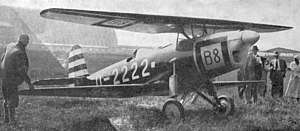Darmstadt D-22
| Darmstadt D-22 | |
|---|---|
 | |
| Role | Sportsplane |
| Manufacturer | Akaflieg Darmstadt |
| First flight | 1931 |
| Primary user | Germany |
| Produced | 1931 |
| Number built | 2 |
The Darmstadt D-22 was a sportsplane of Germany, designed and built by Akaflieg of Darmstadt University of Technology.
Design and development
The plane was designed by F. Fecher in the Akaflieg (academic group of flyers) of Darmstadt University of Technology. It was a development of Darmstadt D-18, slightly enlarged, more streamlined and fitted with an inline engine. Thanks to strengthening it was better fit to aerobatics. Two were built in 1931.
Just like D-18, the plane had quite unorthodox layout, being a cantilever biplane, with an upper wing placed low above a fuselage and ahead of a lower wing. A stress was put upon aerodynamics and lightness and the plane was small, with a streamlined silhouette.
Operational history
One plane, in D-22a variant, took part in the Challenge 1932 international tourist plane contest, piloted by Walter Marienfeld. It was handicapped in technical trials, especially short landing trial, not having wing mechanization, and took the 35th place after this part (for 43 aircraft). It improved its score after a rally around Europe, where it took the 4th place, with a cruise speed 205 km/h. In a maximum speed trial it was beaten only by five Heinkel He 64s, reaching 230.7 km/h. As a result, it completed the contest on the 17th place. This plane carried registration D-2222, from 1933: D-EQIN. It was used several years after the Challenge.
Specifications

Description
Wooden construction cantilever biplane. Fuselage oval in cross-section, plywood covered. Single-spar wings, plywood and canvas covered. Wings were dismounting and folding rearwards. Two open crew cockpits in tandem, with windshields. Fixed landing gear with a rear skid. Inline engine in a fuselage nose, two-blade propeller. Fuel tank 100 l in the fuselage.
General characteristics
- Crew: 1
- Capacity: 1 passenger
- Length: 6.6 m ()
- Wingspan: 7.40 m ()
- Height: 2.4 m ()
- Wing area: 13 m² ()
- Empty weight: 345 kg ()
- Useful load: 255 kg ()
- Loaded weight: 600 kg ()
- Powerplant: 1 × Argus As 8 air-cooled 4-cylinder inverted inline engine, 103 hp (75.7 kW)
Performance
- Maximum speed: 230 km/h
- Cruise speed: 200 km/h
- Stall speed: <81.8 km/h ()
- Range: 800 km ()
- Service ceiling: 6,200 m ()
References
| Wikimedia Commons has media related to Darmstadt D-22. |
- Marian Krzyżan: "Międzynarodowe turnieje lotnicze 1929-1934", Warsaw 1988, ISBN 83-206-0637-3 (Polish language)